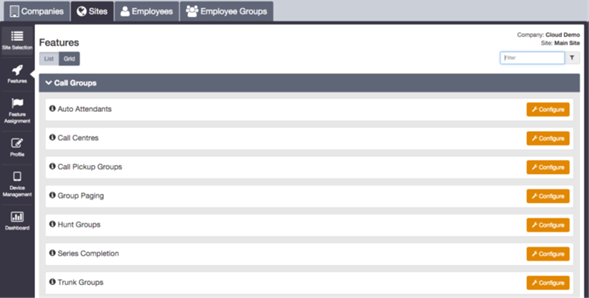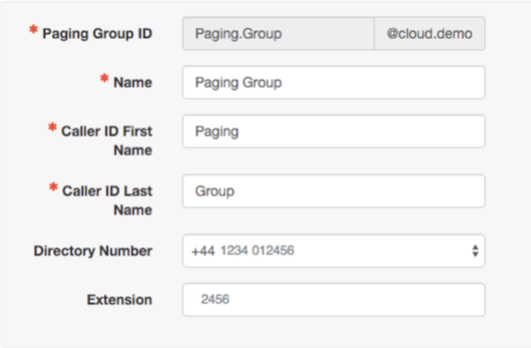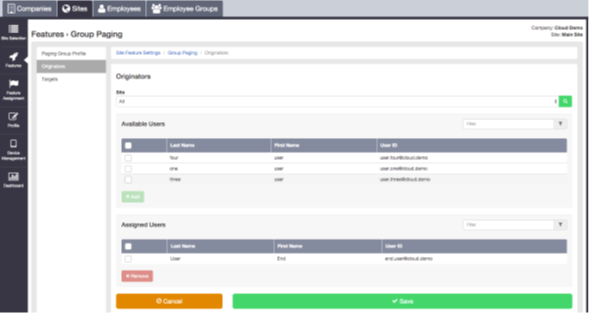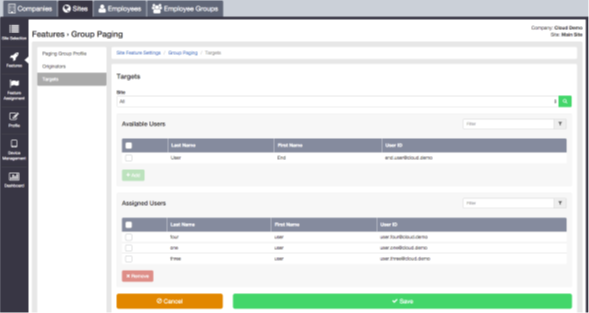
Group Paging is effectively a tannoy type service that enables a message to be sent/paged to multiple users/devices. This is different to Push-to-Talk which is a one to one paging service only.
With Group Paging site administrators are able to configure Paging Groups with a telephone number and assign users as Originators and Targets to be a part of the service. The Originator users have the ability to send a Page to the group, the target users are the recipients of the Page. A user can be both an originator and a target.
When the originator dials the Paging Group number the feature alerts users assigned as targets and connects them into a muted multi-way conference with the originator. The originator can then make an announcement to all the targets.
To configure the feature, navigate to the Business Portal as a site Administrator or higher and select Sites>Features>Call Groups>Group Paging.




The site administrator has the ability to define the list of users who can originate the page to the targets.

Any user within the site or customer of the paging group is allowed to be an originator. In addition, the user can be assigned as an allowed originator for multiple paging groups. A user can be both an originator and a target in the same Paging Group. If the originator is also included in the paging group as a target, the originator is excluded from the list of targets to be paged when they initiate a page.
An originator user can be deactivated even though this user is part of a paging group. Once deactivated, the originator is removed as the allowed originator from all associated paging groups.
The list of users that will receive the page is referred to as ‘targets’.

Any user or paging group within a site or customer can be defined as a target in a paging group. If a paging group is assigned as a target within another paging group this is called a nested paging group, see Nested Paging Groups section below.
When an originator sends a page to a device, the target device will immediately auto answer the page, if supported. If the device does not support auto-answer the target handset must manually answer the call within the ‘confirmation tone sending timeout’ as described above.
A target user can be deactivated even though this user is part of a paging group. Once a target is deactivated, the user is removed from all the associated paging groups.
A paging group can be defined as a target in another paging group, thus creating a nested paging group. The nested paging group will need to be configured as a stand-alone paging group with its own unique configuration and number/extension. This paging group can be directly activated by dialling its assigned telephone number or extension independently. If the number of a paging group is dialled by an originator, all targets are paged, including those in the nested paging groups. The total numbers of users in the nested paging group must comply with the maximum number of targets which is 100.
Please note the nesting of paging groups is limited to a single level of nesting. For instance, Paging Group A can contain Paging Group B and C as nested paging groups. However, Paging Group B cannot contain Paging Group D as a nested paging group. Similarly, Paging Group A cannot be included in any other paging group since it already contains one level of nesting. A paging group cannot be deleted from the system if it is nested inside another paging group.
Auto Answer Handset Requirements
The paging group will always request the target devices to auto-answer the page. To support this, the handset must be able to interpret the supportAnswerAfter SIP parameter in order to auto answer the page. The supportAnswerAfter SIP parameter is supported by the major IP Phone devices which includes the devices we sell from Polycom and Yealink. Therefore, with the standard default configuration these phones will auto answer Group Pages using the speakerphone. Target devices that do not have the ability to auto-answer can manually answer the page within the confirmation tone timeout.
The following conditions must be adhered to in order for the feature to work successfully:
Using the Group Paging Feature
Please note, only one group page attempt is permitted to be active for a paging group at any point in time. If one attempt is initiated and a then second attempt is initiated before the first attempt is completed, the second attempt is rejected.
Article ID: 307
Created: Mon, Feb 15, 2021
Last Updated: Mon, Feb 15, 2021
Author: Darren M
Online URL: https://kb2.ic.uk/article.php?id=307